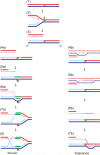Homologous recombination in DNA repair and DNA damage tolerance
- PMID: 18166982
- PMCID: PMC3087377
- DOI: 10.1038/cr.2008.1
Homologous recombination in DNA repair and DNA damage tolerance
Abstract
Homologous recombination (HR) comprises a series of interrelated pathways that function in the repair of DNA double-stranded breaks (DSBs) and interstrand crosslinks (ICLs). In addition, recombination provides critical support for DNA replication in the recovery of stalled or broken replication forks, contributing to tolerance of DNA damage. A central core of proteins, most critically the RecA homolog Rad51, catalyzes the key reactions that typify HR: homology search and DNA strand invasion. The diverse functions of recombination are reflected in the need for context-specific factors that perform supplemental functions in conjunction with the core proteins. The inability to properly repair complex DNA damage and resolve DNA replication stress leads to genomic instability and contributes to cancer etiology. Mutations in the BRCA2 recombination gene cause predisposition to breast and ovarian cancer as well as Fanconi anemia, a cancer predisposition syndrome characterized by a defect in the repair of DNA interstrand crosslinks. The cellular functions of recombination are also germane to DNA-based treatment modalities of cancer, which target replicating cells by the direct or indirect induction of DNA lesions that are substrates for recombination pathways. This review focuses on mechanistic aspects of HR relating to DSB and ICL repair as well as replication fork support.
Figures



References
-
- Friedberg EC, Walker GC, Siede W, et al. DNA Repair and Mutagenesis. 2nd Edition ASM Press; Washington, DC: 2006.
-
- Hunter N. Meiotic recombination. In: Aguilera A, Rothstein R, editors. Homologous recombination. Springer-Verlag; Berlin-Heidelberg: 2007. pp. 381–441.
-
- Sung P, Klein H. Mechanism of homologous recombination: mediators and helicases take on regulatory functions. Nat Rev Mol Cell Biol. 2006;7:739–750. - PubMed
Publication types
MeSH terms
Substances
Grants and funding
LinkOut - more resources
Full Text Sources
Other Literature Sources
Research Materials
Miscellaneous

